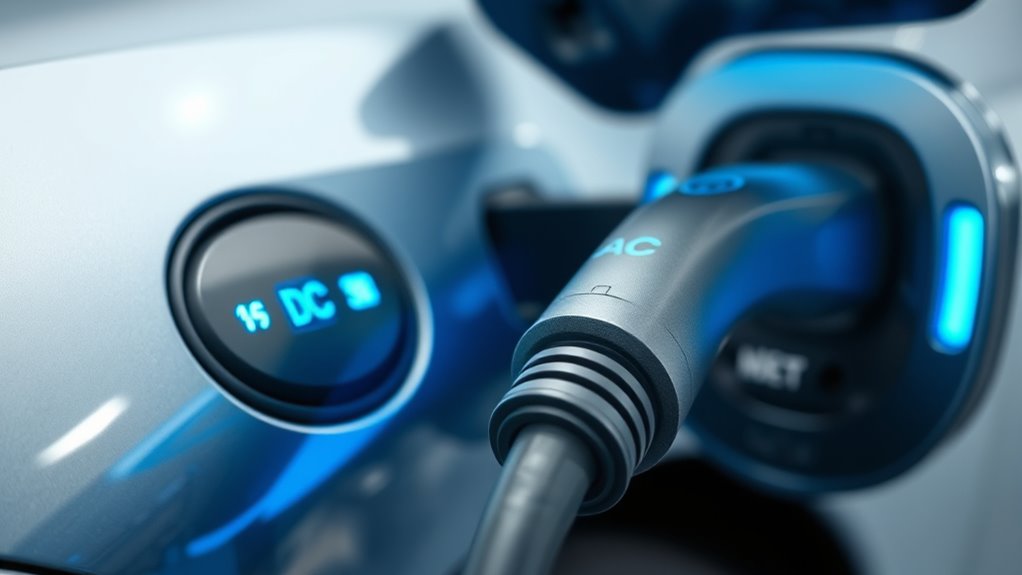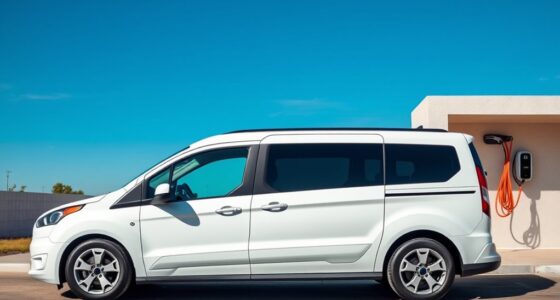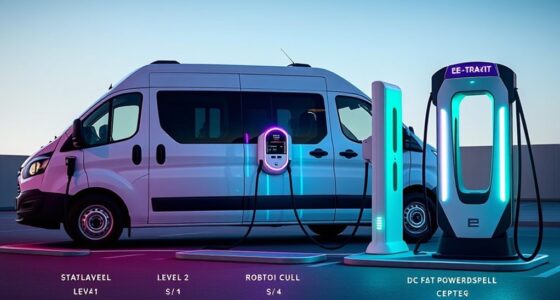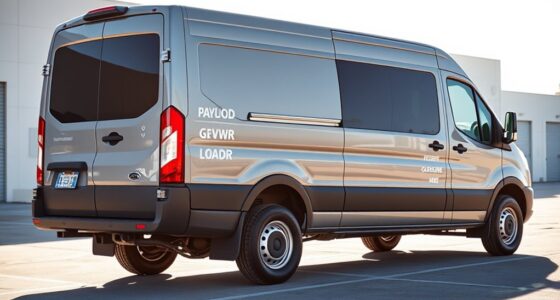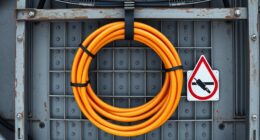When comparing AC and DC charging, you’ll find that AC chargers typically lose about 5-10% of energy due to onboard conversion, while DC fast chargers often lose around 3-8%, thanks to fewer conversion steps. DC charging delivers energy quickly but can generate more heat, leading to slight additional losses. Overall, DC chargers tend to be a bit more efficient, especially during fast charging. If you want to understand how these losses impact your charging experience, there’s more to discover below.
Key Takeaways
- AC charging involves onboard conversion, leading to 5-10% energy loss as heat; DC bypasses this, resulting in fewer losses.
- DC fast chargers typically have 3-8% efficiency losses, slightly better than AC chargers.
- Heat generated in DC chargers from cooling systems can cause additional energy dissipation.
- Faster DC charging increases heat, but shorter charging times can offset efficiency losses.
- Technological improvements in power electronics and cooling systems are reducing overall charging losses.
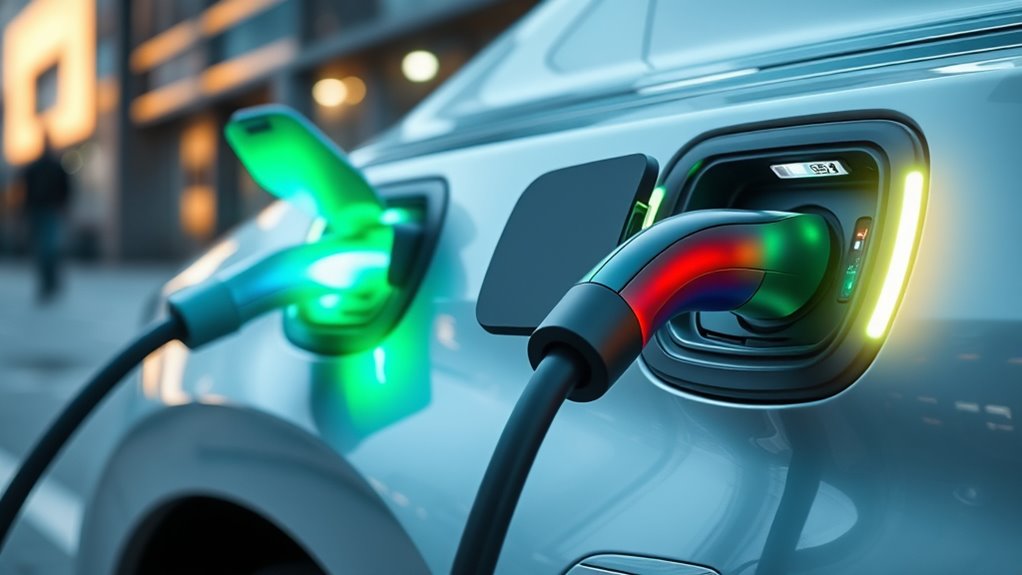
When it comes to charging electric vehicles, understanding the differences between AC and DC charging losses is essential. These losses directly impact how efficiently your EV charges and how long it takes to reach full capacity.
AC (Alternating Current) charging is what you’ll typically find at home or public charging stations. It involves power flowing from the grid into your vehicle through an onboard charger, which then converts AC to DC to store in the battery. During this process, some energy is lost as heat within the onboard charger and wiring, usually amounting to around 5-10%. This means that if you start with a certain amount of electrical energy, a small portion doesn’t make it to your battery, reducing overall efficiency.
On the other hand, DC (Direct Current) fast charging bypasses the vehicle’s onboard charger by delivering DC power directly to the battery through specialized chargers. Because the energy doesn’t need to be converted inside your car, DC charging generally results in fewer losses in conversion.
However, the fast chargers themselves, which are much more powerful, can introduce their own inefficiencies. These stations often have larger cables, cooling systems, and power electronics that generate heat and cause energy to dissipate. Typically, DC fast chargers exhibit about 3-8% losses, which is slightly better than AC charging in terms of raw efficiency. Still, the rapid transfer of energy can generate significant heat, and some losses are unavoidable due to the high power levels involved.
Another aspect to evaluate is the impact of distance and duration. AC charging, with its lower power levels, generally takes longer, meaning the energy loss over extended periods is usually minimal.
Conversely, DC fast charging delivers a large amount of energy in a short span, which can lead to more heat and slightly higher losses during each session. But because DC charging is faster, you spend less overall time charging, which can offset some of the efficiency differences in practical use.
Furthermore, advancements in power electronics and cooling technology continue to reduce these losses, improving overall charging efficiency.
Frequently Asked Questions
How Do Ambient Temperatures Affect AC and DC Charging Efficiency?
Ambient temperatures directly impact both AC and DC charging efficiency. When it’s hot, your charging system works harder, leading to increased losses and slower charging speeds.
Cold temperatures can cause battery chemistry issues, reducing efficiency as well. You’ll notice that ideal temperatures around room temperature help maintain smoother, more efficient charging.
To get the best performance, avoid extreme heat or cold whenever possible, and consider charging in shaded or temperature-controlled environments.
What Impact Does Charging Station Age Have on Loss Rates?
You might notice increased loss rates as charging stations age. Over time, wear and tear can cause components to degrade, leading to inefficiencies.
Corrosion, outdated technology, or loose connections can all subtly impact performance. If you’re using older stations, expect slightly higher energy losses, which means longer charging times or more energy consumption.
Regular maintenance can help, but aging infrastructure naturally tends to become less efficient over the years.
Are There Specific Vehicle Models More Prone to Charging Losses?
Certain vehicle models are more prone to charging losses, especially those with less efficient battery management systems or higher internal resistance. You might notice that older or less advanced EVs tend to lose more energy during charging.
Tesla models generally have optimized charging systems, reducing losses, while some other brands may experience higher losses due to battery design. Always check your vehicle’s specifications for best charging efficiency.
How Do Power Grid Fluctuations Influence Charging Loss Percentages?
Power grid fluctuations can increase your charging losses by causing voltage instability, which reduces the efficiency of your EV’s charger.
When the grid voltage drops or spikes, your vehicle’s charging system works harder to maintain a stable charge, leading to higher energy loss.
To minimize this, avoid charging during peak fluctuation times and consider installing a stabilizer or using a smart charger that can adapt to grid variations.
Can Scheduled Maintenance Reduce Overall Charging Losses?
Scheduled maintenance can definitely reduce your overall charging losses. When you keep your charging equipment and infrastructure well-maintained, you prevent issues like voltage irregularities or equipment inefficiencies that cause energy loss.
Regular inspections, cleaning, and updates help guarantee everything runs smoothly, minimizing power dissipation during charging.
Conclusion
So, next time you’re choosing between AC and DC charging, remember that DC might be faster, but it’s also more “efficient” in draining your wallet with losses. While AC seems like the slow, steady friend, it’s actually the one wasting less power along the way. Ironically, the faster charger could cost you more in energy losses—who knew speed and savings rarely go hand in hand? Sometimes, slow and steady really wins the energy race.
